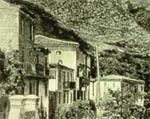|
|
|
The Tirocchis' move to Providence followed a classic pattern of chain migration. Very often one or a few members of a family went ahead to find work and then supported the subsequent migration of their relatives, who in turn encouraged and supported others. The very poor could rarely afford to immigrate, and the wealthier classes were seldom motivated to leave their comfortable situations. Thus, those of modest means and immodest ambitions most often took the chance on a better life and emigrated. The Tirocchis
The Tirocchis’ move from country to city mirrored changes in Italian society at the end of the nineteenth century as Italy--like much of the Western world--was moving from a rural, agrarian economy to an urban, industrial one. Their move also enabled the children to develop skilled trades and to be aided by Mrs. Tirocchi’s employer, who helped find positions for them. In particular, the employer recognized Anna’s talent for sewing and arranged a position for her with an established dressmaker in Rome--one who made clothes for wealthy, aristocratic clients, perhaps even for Italian royalty, as family legend has it. As a young man, Frank Tirocchi came to America to seek his fortune. He prospered by working on the railroad and encouraged his sisters Anna, Laura, and Eugenia to join him, aiding their passage with money he had saved. The Cellas The senior Cellas were both born in Italy. They settled in Providence and had thirteen children, several of whom died of tuberculosis or service in World War I. Several other children moved on, as adults, to California. Louis J. Cella, a younger son, benefited from the work of older siblings, which allowed him to go through the Rhode Island School of Pharmacy and the medical school at the University of Vermont. The Tirocchi and Cella families were united when Frank Tirocchi and his wife, who were running a pharmacy at the time, played matchmaker with Frank’s sister Laura and Dr. Cella, then a young physician who frequented the pharmacy.
^back to
top
|
|
The STORIES
|
|
|
|
|
